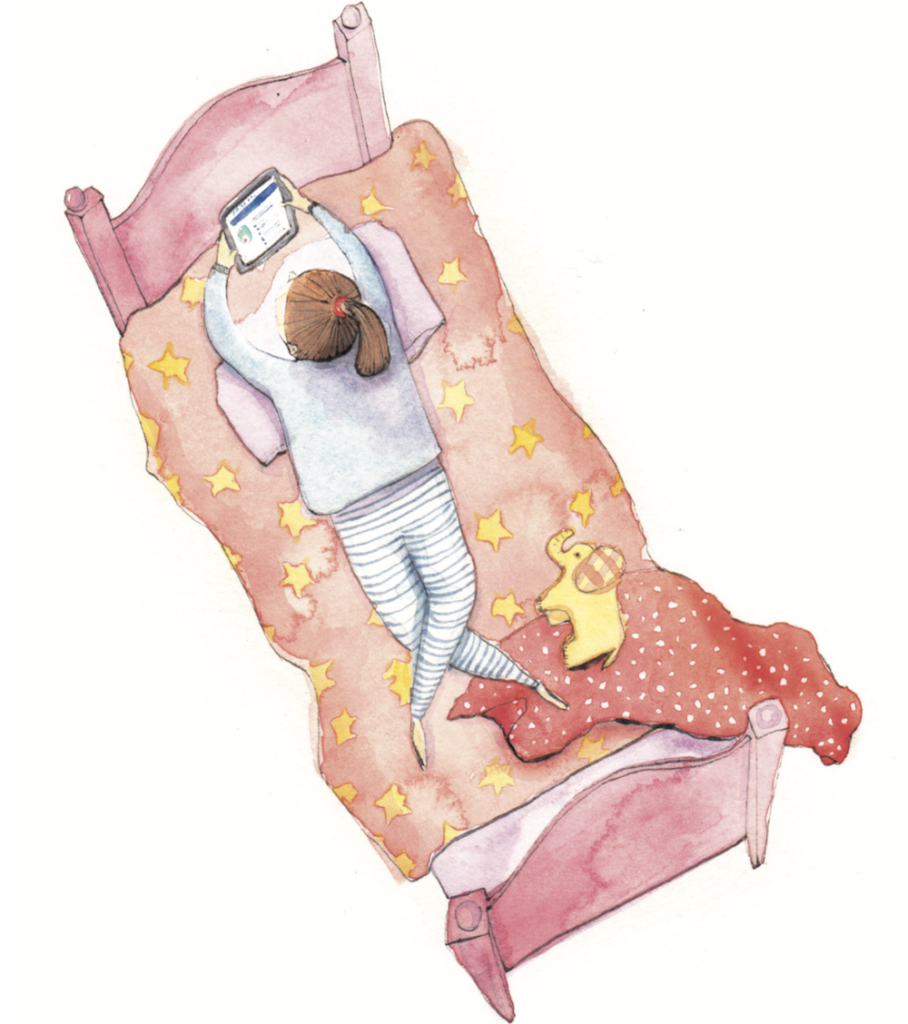Technology is evolving at such a rapid pace that the etiquette surrounding it is, to a certain extent, a work in progress. But even as the landscape evolves, the goal remains the same: teaching our children to harness the benefits of their devices while not allowing screens to degrade the quality of their lives — or ours. After all, we’re navigating our own relationship with technology alongside our digitally-native progeny, and they’re far more likely to watch our behavior than to listen to our advice.
So we work on our own digital etiquette, and demonstrate how to focus more on human engagement than on the smartphones, computers, tablets, and gaming consoles that are increasingly vying for our attention. There are few among us who don’t worry about the impact screen time has on our kids’ emotional and social development, and since they’re going to be using their devices when they’re off on their own, it seems important to establish house rules at an early age to help them balance technology consumption even when we’re not around.
TECH TEMPER TANTRUMS
Most of us have succumbed to offering our children a smartphone or tablet to distract them while ferrying them around on errands, and while sitting in traffic or in waiting rooms. In doing so we’ve helped create the expectation that tech is their go-to entertainment during pockets of downtime, and when their “big-kid pacifier” is removed they can become (unsurprisingly) upset. After all, our kids’ capacity for giving up electronic devices isn’t so different from earlier stages in their lives when they had to give up a pacifier, and the rules of engagement aren’t so dissimilar now.

Illustration by Lydia StarkeyWhen children have tantrums, our best tactic is still to remain calm, compassionate, and consistent, guiding them with logic once they have regained control of their emotions. Our kids may first need to sit quietly with themselves before they’re ready to talk through something, but high emotions don’t last forever, and learning to control them is an important part of our kids’ overall development. Once the tantrum subsides, first ensure that you, yourself, are composed and then have a mindful conversation with your kids, acknowledging their feelings and explaining why they can’t have unlimited use of their screens. Convey why their reaction to those limits has to improve in order to regain privileges with their devices going forward. Temper tantrums are often intended to shape our behavior — don’t give in. We teach our children self-mastery by exhibiting it.
NO SCREENS BEFORE BED
A surfeit of scientific studies concludes that too much screen time before bed can prevent us from having a good night’s sleep. We’ve seen this first-hand in our own family, so we shut off electronics an hour before bed, and at a previously agreed-upon hour, I actually take away their devices for charging. We also offer our kids a compelling substitute: a good book. Encouraging them to read before bed began years earlier when I read to them at night as often as I could. We chose books that would take a good six months to a year to read together — the Harry Potter series, for example, the Roald Dahl books, and the complete Chronicles of Narnia. Reading to children creates lifelong habits that can enrich their vocabulary, boost memory, build their curiosity, and help them settle down happily for bed. And if you’re able to make this a regular routine, it also allows you to spend quality time together.

Illustration by Lydia StarkeyNO SCREENS AT THE TABLE
Whether you have a four-year-old watching videos on a tablet or a tween texting on their smartphone, electronics have no place at the table during mealtime — plain and simple. This is your time to shape family culture and to learn about your children’s day — and for them to learn about yours. Many families use a device basket that’s positioned near the dining table so that everyone can deposit their screens before the meal begins. Children benefit from understanding that they will encounter more structured, formal situations throughout their life, and your home is where they prepare for the larger expectations that ultimately await them. So before dining with the grandparents, or making reservations at that formal restaurant, get into the habit of reiterating your family’s rules of behavior at the dinner table and watch them model that behavior when they’re out in the world.
EYE CONTACT
We’re raising our children at a time when their peers are more comfortable staring at a screen than engaging in face-to-face conversations, and without purposeful structure in our homes — shaped and modeled by us — we’re essentially outsourcing that role to the outside world. When children are on their screens and are being addressed by an adult or another child, it’s important that they know to look up and make eye contact when they respond. (There’s nothing worse than being greeted with a monosyllabic reply and indiscernible head movement.) Eye contact plays a crucial role in a baby’s development and is an important social skill that children will carry with them later into life. Eye contact demonstrates engagement and respect, and it is the groundwork for meaningful human interaction.

Illustration by Lydia StarkeyThe ideal way to instill behavior in our children is to first model it ourselves. In essence, we need to ensure that we look at our children, not our screens, when they are speaking to us. This ends up being harder than it sounds, since many of us receive work- related emails around the clock. As we often check emails first thing in the morning, managing the no-phone rule at breakfast quickly becomes complicated. If you have to respond to a work email or text, first excuse yourself from the table, let your child know that the message is for work, and that, once it’s done, you will be back at the table with your full attention. They deserve that from you, and you deserve children who value your effort to do so.
GAMING
As a mother of five, I know more about gaming than I ever imagined I would — from creepers in Minecraft to the array of Fortnite battles. What both of these have in common, however, is that they can be played as multiplayer games, which means that children can interact with strangers on public servers. Accordingly, I only allow my children to use a private server, and I insist they create avatars and never use their real names. Another rule I have set — which can be hard to enforce when your child is working with a squad on a real-time video game — is limiting gaming to an hour a day. In addition, this hour isn’t a given, as they’re not allowed to play unless their homework is first completed and any chores or required reading is done. You’ll surely hear groans, as do I, but after completing these tasks our kids end up being more appreciative of their gaming downtime because they have “earned” it.

Illustration by Lydia StarkeySHARING
Having multiple children in our homes doesn’t mean we have multiple gaming systems, tablets, and computers: learning to share is a valuable part of growing up, and it is a life skill our kids will eventually thank us for. (Just not any time soon.) As adults we have a difficult enough time waiting our turn, but we all did learn to do it during our own childhoods. Do you remember having to share that one landline in the house? In order to help our kids share an electronic device without friction, we can ideally set up a schedule together with our children. Sit down and create a calendar that the kids can refer to, even when you’re not there to enforce the rules that they, themselves, helped create.
SOCIAL MEDIA
Social media can be addictive at any age, so before we focus on our children’s consumption of it, we would do well to check the example we ourselves are setting for them ourselves. On family vacations, are we paying more attention to curating our experiences for social media than we are immersing ourselves in the moment? If so, then there are likely little people taking notice. Teach them by example to live engaged lives in the present before even considering how it will look on your/their Instagram feed.

Illustration by Lydia StarkeyFOMO AND FINSTA
The research is in, and it’s sobering: spending too much time on social media contributes to childhood/ teen anxiety and depression. A primary responsibility as parents is to monitor how social media impacts our children’s mood and their sense of well-being. While social media can be a wonderful tool for expanding and reinforcing friendships, it also has the potential to considerable damage to our kids’ self-esteem. Setting boundaries is a good start — as is knowing our children well enough to recognize changes in them. Fear of missing out (FOMO) and cyberbullying pose some of the greatest risks, and while our children may initially bristle at our involvement, they ultimately appreciate knowing that we care about them.
Keeping a watchful eye on our children’s social media accounts includes the insight that children can be very creative when it comes to carving out their privacy in this new world. If you don’t yet know the difference between a finsta and a rinsta (fake and regular Instagram accounts), then you and your kids may need to have a talk, because kids learn early on how to hide their “real” social media presence from their parents. Talk to them about what is, and isn’t, appropriate to post on social media, and don’t wait until the tween or teen years to start these discussions.
TAKING THE PLUNGE, TOGETHER
Most platforms cite 13 as the age when people can create accounts, but it’s up to parents to decide what age we actually consider appropriate. (I suggest putting it off for as long as possible!) If your child is pressuring you to open an account or to get a smartphone, it’s a good idea to raise the topic with the parents of your child’s classmates and collectively make a decision. If all the parents adopt the same policy, you’ll avoid the otherwise inevitable situation — and ensuing argument — when your child comes home from school demanding a social media account or a phone at age eight because so- and-so has one.

Illustration by Lydia StarkeyAs my kids became older, I did let them join some controlled social media sites, but I always ensured that the viewing settings were on “private.” These days, preparing our children for the real world begins by preparing them for the world online. Teach them about cyberbullying, emphasizing mindfulness in the way they communicate with others, and help them avoid hurting someone else’s feelings. I always tell my children to imagine what their grandmother would think before they post a message or picture. If your child is the one whose feelings have been hurt, prepare yourself to be an active listener, and remember that kids aren’t always looking for a remedy; sometimes they just want a sympathetic ear.
POST HASTE
If you’ve been embarrassed by something posted by your child, you are not alone. Children’s brains are, of course, still developing, and at times they won’t make the best decisions. Help them understand that anything they share may one day be viewed by a school admissions director, future in-laws, or potential employers. Everything we share on the internet can be made permanent, even if it’s within a private account (hello screenshots!) So if it’s something they wouldn’t be happy for anyone, and everyone, to see, advise your kids not to post it. It’s also important for children to be careful about who is following them.
Many of them let friends of friends follow their accounts, and some ascribe to the “more the merrier method” when it comes to boosting followers, often considering it a kind of popularity contest. So review your children’s social media contacts with them and have open discussions about why they’re allowing certain people into their private world; it’s a good way to open bigger discussions about their school and social life, their friends and themselves. Social media is, in many ways, a mirror. Do you — do they — like what they see reflected in it?

Illustration by Lydia StarkeyTEXTING
If you have a tween or a teen, your child is probably already texting on a tablet, smartphone, or social media app. And even if this tech didn’t exist, they’d be on your house phone doing essentially the same thing that they’re doing on their devices: expanding their circle to people beyond your immediate family. So many of the things we face on this front as parents have nothing to do with tech, and everything to do with sharing our children with a group of people we may not yet know. Stick to your instincts on this, because you yourself made it through your own version of this stage. And of course, devices add their own layer of obstacles to navigate.
By the age of ten, your children may be participating in group-text conversations, sometimes including a dozen kids or more. Groupthink sometimes sets in, and it rarely inspires kids to be their best selves. I advise my children not to text anything they’re afraid to say in person. I also make sure they are aware that texts, direct messages, and emails can be made into screenshots and passed along to others. Often this is done out of context, and it can be used to hurt another child’s feelings. This is a good opportunity to teach children about a no-bullying house rule: in your family, no one is allowed to be mean to other people.
No matter what their age, children should shut down communications on devices within an hour or so of bedtime. And it should be a given that children don’t text at the movies, the theater, school events, family gatherings, religious services, or any place where they should be focusing their attention on something, or someone, else. Distracted driving, or even distracted walking, should be an important point of discussion and, as ever, we should lead by our own example. Don’t use a crosswalk while looking at your phone, and use your phone’s settings to silence all incoming calls and texts while you’re driving. Our children take their cues from us.

Illustration by Lydia StarkeyTECH IS NOT THE ENEMY; BAD HABITS ARE
Technology has the capacity to be the hub of our family’s wheel if we put it to good use, and making a family plan to do just that is your first step. If you have older kids, you’ve likely already found that text messages are a great way to keep a conversation open with them as they spend more time away from home; grandparents love video calls with our kids, and family group chats keep everyone connected no matter how far away they live.
While every family has their own set of circumstances and eventual solutions, we can all benefit from developing a consistent structure to follow as we calibrate such bedrock rules as appropriate time and circumstances for screen usage. Routine and boundaries have a way of defusing battles before they even begin, and with computer dependency only growing, we would do well to create an atmosphere of reasonable expectations within our home — rules our kids can understand and then commit to following.
Adapted excerpt from Manners Begin at Breakfast: Modern Etiquette for Families by Princess Marie-Chantal of Greece. Copyright 2020 by the author and reprinted by per- mission of Vendome.



